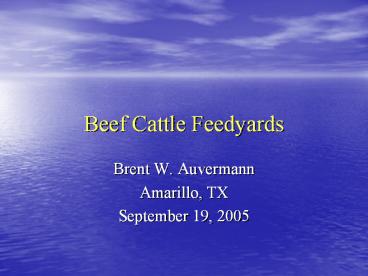Beef Cattle Feedyards - PowerPoint PPT Presentation
Title: Beef Cattle Feedyards
1
Beef Cattle Feedyards
- Brent W. Auvermann
- Amarillo, TX
- September 19, 2005
2
Industry Description
- Major cattle-feeding states TX, KS, NE, IA, OK,
CO, ID, WA, AZ, CA - 25 million hd/yr produced on feed
- 30 produced within 150 mi of Amarillo, TX
- Increasingly dominated by multi-feedyard
corporations (5-10 feedyards, 350-600,000 hd) - Deaf Smith Co. (TX) gt 1,000,000 hd
- Alberta is Canadas 1 cattle-feeding province
3
Feedyard Description
- Average one-time capacity increasing varies
geographically (40,000 in southern High Plains) - One-time capacity x 2.2 annual throughput
- 365/2.2 165 days per feeding period, or turn
depends on beginning liveweight - Feed-to-gain ratio 6 (approx.)
- Beginning liveweight 350-750 lb.
- Market weight 1,100-1,300 lb.
4
Feedyard Description
- Average daily gain (ADG) 3-4 lb/hd/d
- Daily intake averages 20-25 lb/d dry matter (DM)
- Average water use varies seasonally 8-15
gal/hd/d - Feed digestibility gt80
- Each animal may receive up to 3 or 4 different
rations through feeding period - Starter (high roughage)
- Step-up or transitional
- Finishing (high energy may exceed 90
digestibility) - Manure production 0.75-1 dry ton/hd (cap)/yr
- Corn, sorghum, distillers grains, potatoes, other
5
General Layout
- Stocking density 1/cattle spacing
- Typical cattle spacing 150-200 ft2/hd
- Total corral area 3.5-4.5 ac/1,000 hd capacity
- 45,000-hd yard covers 200 ac including ancillary
areas (feed mill, manure handling, holding ponds
etc. - Typical SCS Runoff Curve Number 90-95
6
Manure and Wastewater Handling
- Predominant form solid manure
- Corral scraping gt1/yr
- May be composted (low N), stockpiled, mounded or
directly land-applied (higher N) - NP2O5 ratio around 1-1.5
- Cereal crops require NP2O5 ratio of 2.5-3.5
- Over-apply P or under-apply N
7
Manure and Wastewater Handling
- Liquids
- Usually little to no process-generated wastewater
- Rainfall runoff full containment (25-yr/24-h)
- CN 90-95
- Management objective rapid drainage
- Improves manure quality, reduces odor/dust
potential - May be enhanced by mounding
- Old vs. new construction practices
- Overflow waterers (winter only)
8
Runoff Holding Ponds
- Designed to meet EPA no-discharge standard
- No hydrologic connection to ground water
typically ensured by clay (in situ or imported)
or geotextile liner - Clay liners gt18 with Ksatlt10-7 cm/sec
- Management objective EMPTY
- Irrigation-based systems
- Evaporative systems
9
Threats to Water Quality
- Surface water
- Excess nutrients from land application
- Solid manure is P-rich
- Historical NMPs (where used) based on N req.
- Tailwater from wastewater irrigation
- Holding pond overflows
- Soil erosion, rainfall runoff
10
Threats to Water Quality
- Ground water
- Excess nutrients from land application
- Inorganic N is highly soluble organic P also
- Shallow water tables (e. g., S. Platte River, CO)
- Unprotected wellheads, old well casings
- Poor liner construction or installation
- Sweeten et al. (early 1990s) found little to no
WQ impact from feedyard holding ponds in Texas
Panhandle
11
National Trends
- Steady growth and expansion, but not many new
feedyards - Net flow of P from mines in FL to Corn Belt to
cattle-feeding states (B. Stewart, WTAMU) - Declining water tables in High Plains will reduce
irrigated acreage, crop yield and sustainable
fertilization rates - Above-average growth in semi-arid West
- Accelerated P-based nutrient planning
12
Other Trends
- Koelsch et al. (2002) found that the ratio of
nutrient inputs to managed outputs (meat,
crops, marketed manure) frequently exceeds 1.0
and may approach 6-10 in extreme cases - Confirms Smolen et al. (late 1990s) finding of
significant nutrient concentration in OK
cattle-feeding counties - Dead animal disposal a growing concern
- Rendering a vanishing prospect for many remote
producers - Burials time is short
- Incineration is energy intensive
- Out of sight, out of mind
- Biosecurity
- Water and air quality
13
Other Trends
- Energy production from manure and manure products
is returning - 60/bbl crude
- Shifts WQ burden incrementally to power plants
(ash dry and wet deposition of stack emissions) - Airborne NH3 dissolves readily in downwind
surface water emissions to be regulated
eventually due to secondary PM2.5 production,
CERCLA/EPCRA implementation - Secondary PM2.5 formation is a sink for acidic
(SOx, NOx) and alkaline (NH3) gases - Fugitive dust showing up as a source of soil
nutrient enrichment downwind of cattle feedyards































